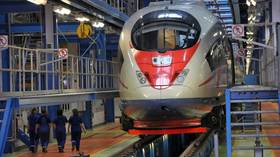Russian Railways launches ‘import substituted’ train
The first passengers have traveled from Ekaterinburg by ‘Finist’, an analog of the ‘Lastochka’ train made by German firm Siemens
Russian Railways (RZD) put its first fully “import substituted” train into service on Thursday, the company’s press service has announced. Passengers were transported on the ‘Finist’ train from Ekaterinburg to the city of Kamensk-Uralsky in Sverdlovsk Region.
Finist is expected to operate on new routes in the region and elsewhere in the country next year, RZD said in a statement.
The company explained that the name Finist means ‘phoenix’ in Russian, and is a symbol of rebirth. “Such an image exactly repeats the fate of Lastochka, which underwent a rebirth from a completely foreign electric train [Siemens] to a completely domestic one,” it said.
The first four trains manufactured at the Ural Locomotives plant have been put into service on the Sverdlovsk Railway, which runs through the Urals and Western Siberia. Another eight will be ready for operation by the end of the year, RZD said. It also noted that this model will become the basic platform for “a whole range of high-speed electric trains of a new generation.”
Like Lastochka, Finist can travel at speeds of up to 160kph (99mph). The five-car configuration has 401 reshaped seats for increased comfort, while the last version of Lastochka, built in Russia together with Siemens, had 346. All seats are equipped with USB sockets. Compared to the Siemens model, the number of toilets for five cars has been increased from two to three, and baby-changing tables have been added, Russian Railways said.
In May 2022, Munich-based industrial giant Siemens announced its withdrawal from Russia after 170 years of doing business in the country, due to EU sanctions imposed on Moscow following the escalation of the Ukraine conflict.
Siemens started cooperation with Russian Railways in 2004, when the pair signed a contract for the German company to develop a high-speed passenger train for the Moscow-St. Petersburg route.
Siemens said last week that its decision to leave the Russian market had resulted in a loss of €600 million ($650 million) in the 2022 fiscal year. Under contract to Russian railways, Siemens developed and built the high-speed Sapsan train which travels at up to 250kph (155mph) and Lastochka, as well as a network of depots for their maintenance and repair. The company’s subsidiaries produced railway electrical equipment and traction motors.
You can share this story on social media:








Comments are closed.